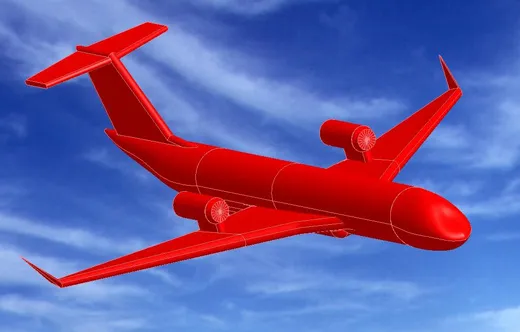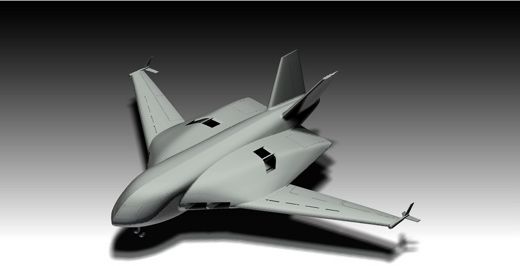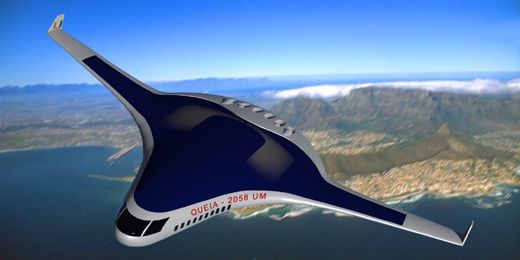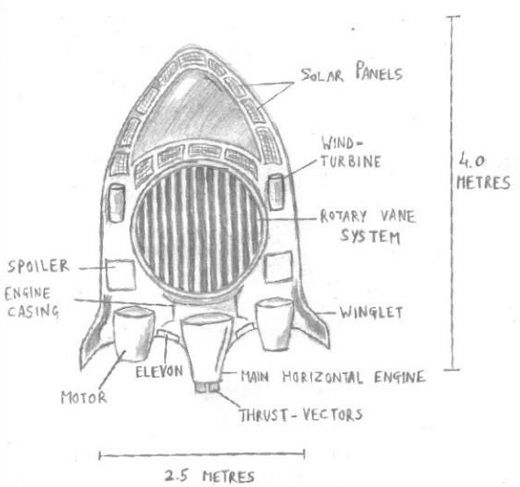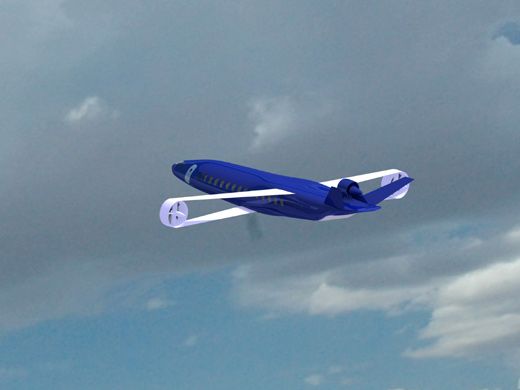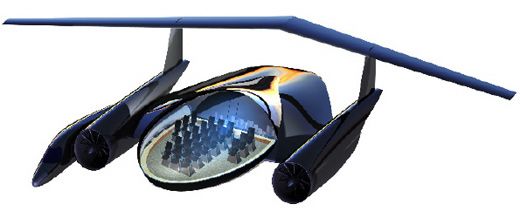Inexperience Wanted
Student engineers answer NASA’s call to design the airplane of 2058.
/https://tf-cmsv2-smithsonianmag-media.s3.amazonaws.com/filer/students-flash.jpg)
We don’t care how old you are, says NASA. If you can dream it up, show it to us. A huge flying wing that looks more manta ray than airplane? An airliner with a V-shaped tail and a brawny fuselage with hidden engines? A commuter airplane with forward swept wings, its cockpit off to one side like the flight deck in Han Solo’s Millennium Falcon?
Don’t frown. You might fly in one someday, designed by someone who just got his driver’s license.
“We’ve been away from these [futuristic] concepts for too long,” says Dennis Bushnell, Chief Scientist at NASA’s Langley Research Center in Hampton, Virginia. “If you Google ‘revolutionary aeronautics,’ if you Google ‘advanced aircraft configurations,’ what you get is that [NASA] essentially went out of this business in the late 1970s.”
Bushnell is describing the seventh annual aircraft design contest for college students, run by the agency's Fundamental Aeronautics Program. This year, 61 students from 14 colleges and universities worldwide answered the call, which asked for conceptual designs of an aircraft that would redefine flying 50 years from now—the way the Douglas DC-3 did in the 1930s.
Contest guidelines mandated that the airplane can carry up to 50,000 pounds of human or other cargo and operate at speeds equal to those of current airliners, between 595 and 625 mph. It should be able to take off and land on runways between 1,500 and 3,000 feet long, to make it available to thousands of short, underused airstrips. And because the theoretical airplane will fly in the year 2058, the contest requires that it burn alternative, environmentally friendly fuels, and do so more quietly than the engines of today.
For the sixth year in a row, NASA held a separate competition for high schoolers, with more relaxed guidelines (the students were asked to match the paradigm-shifting impact of the DC-3). Entries came in from more than 140 students in 50 schools and 15 nations.
Both contests aim to infuse NASA with fresh ideas and inspire a new generation of students to work in the aerospace sector. Entrants receive real feedback on their designs from the dozen NASA engineers, including Bushnell, who served as judges.
“As we go through the educational process, creativity and imagination can get sucked out of you,” says Bushnell. “I reviewed all the entries for both high school and college. The most imaginative ones were high school entries. We had a superb one from a high school kid in Singapore.”
That student, 18-year-old Aditya Singh, won in the category for ideas submitted by non-U.S. high schoolers. His proposal, a two-seat personal air vehicle he named the Dodo (see pictures of his design and others in the photo gallery at right), incorporates an array of modern concepts such as a reduced blended wing body, lightweight composite materials, and two horizontal electric motors to supplement a lightweight Wankel rotary engine.
“I’m personally obsessed with the idea of a personal air vehicle,” says Singh. “My first inspiration which got me down to serious thinking was the Green Goblin’s glider in Spider-Man. I’m sure such an idea can be exploited and taken further for the benefit of all. A quick glance at history shows us that humans consistently shift to technologies which make lives easier for them; in fact, better for them. From walking to bullock carts to cycles to trains to cars.... Aircraft will be the next revolution in everyday transportation.” Singh hopes to enter the Massachusetts Institute of Technology next year to continue studying aeronautical engineering.
Among the college entries, an eight-person team from Georgia Tech won in the graduate student category for their biplane of the future. A high-lift, low-drag, straight-wing design, it carries large rotors at the wingtips that spin from the force of air sweeping off the end of the wing—energy normally wasted, but, in this concept, fed back to the system.
“Aviation needs a revolution in vehicle design,” says Georgia Tech team member Kemp Kernstein. “This aircraft attempts to regain many aspects of lost energy in flight, use more efficient systems, operate at more efficient power settings, all while keeping the noise as low as possible.”
A six-person team from Virginia Tech, all sophomores, won in the undergraduate slot with a design called STINGRAE, for Short Take-off Integrated Nacelle-less Geometry for Reduction of Acoustics and Emissions. The airplane’s four engines are enclosed in a quasi-blended wing body to increase lift and reduce drag. And because jet engines operate most efficiently at maximum thrust, says team member Stephen Pace, pilots would use all four engines on takeoff. Then, during cruise, they’d power off two of them while operating the other two at max throttle.
“The problems facing our nation and planet regarding energy and environmental sustainability are immense,” says Pace. “The absolute most important performance advantage of our design is lower specific fuel consumption. [We’re] proud to be acknowledged by NASA for contributing to the solution.”
A University of Miami team placed second in the undergrad category with a 250-passenger, blended wing body called QUEIA, for Quiet Ultra-Efficient Integrated Aircraft. “We decided that we could take the flying wing design to the next level,” says team member Joseph Dussling. A key feature is the Co-Flow Jet concept, he says, with engines embedded in the top part of the trailing edge to increase lift. The team’s computational fluid dynamics calculations show that QUEIA’s lift-to-drag ratio would virtually double that of a Boeing 737 or even the new 787.
Three members of the design team will return to Miami this fall for their senior year. “The team is actually very excited about the future of QUEIA,” says Dussling. They’ve received funding for the continued development of their design, and the work they’ve done thus far has provided a huge head start, which they’ll build upon for their senior design project.
“QUEIA and the Boeing 737-800 have comparable maximum payloads,” he says. “QUEIA, however, uses about half of the fuel load while having a range 2,000 nautical miles superior to the 737-800. This is incredibly desirable as the cost of oil continues to rise.”
Even one of the more conventional designs, submitted by eight sophomores from Ohio State University, turned ordinary notions of airliners upside-down. Called PUMA (no acronym, just a big cat with a big leap), their 125-passenger short-take-off-and-landing airplane carries its two General Electric CF34-10 turbofans mounted above the wing as a hedge against ingesting foreign objects. And the aircraft is super light due to the use of composites such as carbon/epoxy compounds and Weldalite 049, a lithium-aluminum alloy, which allows it to use short runways.
“The airline industry is primed for another revolution as consumers demand better fuel economy, greater access to smaller airports, and reduced environmental impact,” says team member Kevin Disotell. “Our team came to see that all of these challenges are fundamentally connected to one another.” Disotell says the entire team entered the competition having completed only an introductory aerospace engineering course. They still placed third. “The learning curve for fundamental design concepts was certainly steep with our inexperience,” he says, “but we came to understand that the design process is a science in itself. Design is just like playing an instrument—one only gets better at it through practice and iteration.”
It can also have financial rewards. The first place teams in the NASA college contest divvied up $5,000 each; second and third place teams won $3,000 and $2,000 respectively. International students will receive engraved plaques. And six U.S. students received a 10-week paid summer internship at NASA’s Ames, Dryden, Glenn, or Langley Research Centers. Depending on the center and its regional cost of living, the internships were valued between $6,500 and $8,500, a taste of the income students can expect from a career in aerospace engineering.
Australian Gary Redman won first place in the international college category with an aircraft he named OIONOS for the birds of prey the ancient Greeks watched to foretell the future. A commuter, his design seats 24 passengers clustered beneath an enormous canopy that floods the cabin with natural light. The cockpit, which looks something like an eel protruding from the right side of the plane, is separated entirely from the cabin for an added measure of security.
“The aviation design industry in Australia is moribund,” says Redman. “Aviation in Australia has declined to the point that we as a nation have become an outpost for singular parts manufacture and aircraft repair. This competition allowed me to show that Australian universities turn out students as good as anywhere. Consequently, instead of having 200 million people in front of me, I now am one of 20 or so students showing a direction for the future of aviation.”
Keep an eye on the Langley Research Center’s website for news of the 2008-2009 competition—the Fundamental Aeronautics Program will announce the terms of the contest by September 1. So far, they’ve allowed only that they’ll be looking for supersonic designs.
